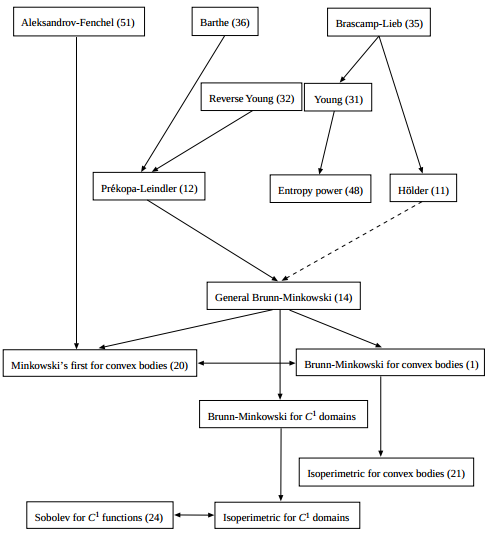I'm a bit hesitant to resurrect an old post, but as a result of some of the things I worked on recently, I'd like to share a new answer to the question in the title. Hopefully some will find it interesting.
First, one bit of notation. For random vectors $X,Y$ defined on a common probability space, let $I(X;Y):= H(X)+H(Y) - H(X,Y)$ denote their mutual information. This quantity is nonnegative, and identically zero iff $X,Y$ are independent.
Now, for random vectors $X,Y$ (of dimension $n$) with given marginals and any $\zeta\geq 0$, a recent result by Efe Aras and myself [5] implies
\begin{align}
e^{2 H(X)/n} + e^{2 H(Y)/n} + 2 {(1-e^{-2 \zeta/n})^{1/2}}e^{H(X)/n}e^{H(Y)/n} \leq \sup_{\text{couplings of }X,Y : I(X;Y)\leq \zeta} e^{2 H(X+Y)/n}, \tag{1}\label{ISIT2021}
\end{align}
where the supremum is over all couplings of $X,Y$ such that $I(X;Y)\leq \zeta$.
If $\zeta=0$, then the only admissible coupling is the one where $X$ and $Y$ are independent, recovering the Shannon-Stam entropy power inequality (EPI):
$$e^{2H(X)/n} + e^{2H(Y)/n} \leq e^{2H(X+Y)/n}.$$
On the other hand, if $\zeta=+\infty$, then we find
\begin{align}e^{H(X)/n} + e^{H(Y)/n} \leq \sup_{\text{couplings of }X,Y} e^{H(X+Y)/n},\tag{2}\label{entropyBM}
\end{align}
where the supremum is now unrestricted, over all couplings of $X$ and $Y$.
Roughly speaking, by transitioning from independence to dependence, we gracefully transition from exponent 2 to 1, which is a salient difference between the EPI and the Brunn-Minkowski inequality (BMI), as pointed out by Terry Tao. So, one might consider this as an explanation of how the BMI can be seen to emerge from a general relationship on Shannon entropies. More specifically, the above demonstrates how the EPI and BMI can be thought of as occupying opposite extremes in a continuum of entropy inequalities, rather than as one inequality implying the other. (As a remark, \eqref{ISIT2021} is sharp for all $\zeta\in [0,+\infty]$, as seen by testing on Gaussian vectors.)
To clarify why \eqref{entropyBM} implies the BMI, note that if $X$ is supported on a compact set $K$, then $e^{H(X)}\leq m(K)$, with equality iff $X$ is uniformly distributed. Thus, for $X$ and $Y$ uniformly distributed on compact sets $K,L\subset \mathbb{R}^n$, respectively, the sum $X+Y$ is supported on the Minkowski sum $K+L$, and \eqref{entropyBM} gives:
$$
m(K)^{1/n} + m(L)^{1/n} \leq \sup_{\text{couplings of }X,Y} e^{H(X+Y)/n} \leq m(K+L)^{1/n}.
$$
The slack in the second inequality is governed precisely by the relative entropy between the distribution of $X+Y$ and the uniform distribution on $K+L$, minimized over all couplings. In this sense, it gives a quantitative reinforcement of Terry Tao's last sentence:
The problem here, of course, is that the sum of two uniformly
distributed independent random variables is almost never uniformly
distributed.
except we can strike the word independent.
I'll close by saying a few words about how \eqref{ISIT2021} comes about. In the Gardner figure reproduced above, one can place a larger family of inequalities at the top of the hierarchy that implies the Brascamp-Lieb (B-L) inequalities, the Barthe inequality, and the reverse Young inequality. Jingbo Liu (together with myself, Cuff and Verdu) introduced this family of inequalities in [1], and called them "forward-reverse" B-L inequalities because they simultaneously generalize the "reverse" B-L inequality due to Barthe, as well as the original forward/direct B-L inequalities. In their 2009 paper, Carlen and Cordero-Erausquin observed that the direct B-L inequalities have an equivalent dual formulation in terms of Shannon entropies [2]. The same can be said for the class of forward-reverse inequalities; it was this connection to entropies that motivated our original study of the forward-reverse inequalities. Inequality \eqref{ISIT2021} can be considered as one instance of the latter in the Euclidean setting, which retains much of the nice structure Bennett, Carberry, Christ and Tao [3] described for the direct B-L inequalities (see [4] for the forward-reverse setting). Thus, coming back to the original post, it is possible to see how everything fits neatly into a larger hierarchy than the one depicted by Gardner (or, rather, an entropic dual formulation of Gardner's hierarchy), where the "entropy connection" between the EPI and BMI can be made more transparent.
Of course, as Mokshay Madiman pointed out in his answer, both the EPI and BMI can be obtained as limiting cases of Young's inequality, which can be stated in terms of three different Rényi entropies, thereby giving some kind of "entropy" proof of the BMI. However, I think the spirit of the original question was asking about Shannon entropies, for which this answer might be more satisfactory.
[1] Liu, Jingbo, Courtade, Thomas A., Cuff, Paul W., & Verdú, Sergio. A forward-reverse Brascamp-Lieb inequality: Entropic duality and Gaussian optimality. Entropy, Special Issue on Information Inequalities, 20.6 (2018), 418.
[2] Carlen, Eric A., and Dario Cordero–Erausquin. Subadditivity of the entropy and its relation to Brascamp–Lieb type inequalities. Geometric and Functional Analysis 19.2 (2009): 373-405.
[3] Bennett, Jonathan, Anthony Carbery, Michael Christ, and Terence Tao. The Brascamp–Lieb inequalities: finiteness, structure and extremals. Geometric and Functional Analysis 17, no. 5 (2008): 1343-1415.
[4] Courtade, Thomas A., and Jingbo Liu. Euclidean forward–reverse Brascamp–Lieb inequalities: Finiteness, structure, and extremals. The Journal of Geometric Analysis 31.4 (2021): 3300-3350.
[5] Aras, Efe, and Courtade, Thomas A. Sharp Maximum Entropy Comparisons. Proc. of the 2021 IEEE International Symposium on Information Theory (ISIT), pp. 1504-1509. IEEE, 2021.

